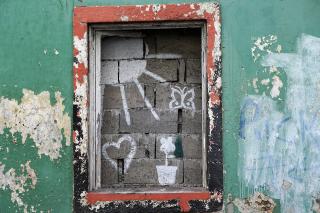Look for the Unbuilders
By Natalie Briscoe

One of my favorite teaching stories is “The Carpenter and The Unbuilder.” The main character of the story is the Carpenter, who is the most skilled tradesperson in the whole country. The Ruler hears of the Carpenter’s accomplishments and sends an invitation to come to the palace for dinner. The Carpenter, who is used to construction, spends a long time – years even – preparing for the journey. Etiquette lessons, new clothing, and classes in politics and current affairs all must be acquired before the journey can even begin. Once the trip is underway, the Carpenter finds many reasons to stop along the way: building elaborate, beautiful, and – most importantly – comfortable houses to stay in. The Carpenter often allows fear of the unknown and of their own inadequacy stall the journey. These detours keep happening until one day, the Carpenter meets the Unbuilder. The Unbuilder shows the Carpenter how to dismantle, take apart, and “unbuild” the structures around them so the journey can continue. The Undbuilder teaches the Carpenter that it is impossible to reach the Kingdom if these things we have built – no matter how beautiful – keep distracting us. Sometimes we aren’t building homes; we are building prisons.
This story is a metaphorical telling of our journey through Faith Development. We begin at home, learning what we can trust, what we can rely on. We hear the stories of who we are, and we learn to tell those stories to others. We come to know these stories as part of our history, our identity, and our legacy. We build lots of structures – churches, curricula, pedagogy, programs, worship services, polity, governance – around the truths we hear in these stories. Our love of the story, the story that informs who we are, transfers to a love of these structures we’ve built. They are comfortable to the Carpenters. The Carpenters learn to recognize other Carpenters, the people who are skilled at building like they are. They tell them the stories, and together, they make something bigger than themselves. Individuals spend a lot of time in this building stage as Carpenters and often leave a great legacy of structures behind them. James T. Fower, the author of “Stages of Faith Development,” calls this stage “Synthetic-Conventional.” It is a community-based stage, where building a community of those who know our stories is important to us.
Eventually, on our Journey of Faith Development, we meet the Unbuilder. The Unbuilders can be inside our UUA and outside; inside of our member congregations and outside; inside our own souls, and outside. Meeting the Unbuilder, in the metaphorical sense, ushers in the stage Fowler would call the “Individuative-Reflexive Stage” of Faith Development. The things we built with such care and time must be deconstructed. Where once they were vehicles to bringing the story to life, they are now the things which stand in the way of our journey. We must take them apart in order to remember what about them was so important to begin with. This part of the story – this Stage of Faith – is scary and often very painful. We have worked so hard to build these structures. It’s hard to let go. It’s hard to see them torn down. And yet, if we don’t do this, we are stuck. Our stories and the values they represent are held captive to the structures, and we become unable to move forward on our Journey to a deeper Faith.

The moral of the story is this (and it is more true this very second than ever before):
Unitarian Universalists have long misunderstood themselves in the context of religious mission.
The purpose of the church is not to have the church.
Unitarian Universalism can save the world, but we don’t let it. We lock it away in scaffolds and structures. We confine it to process and systems. We build walls to hold it prisoner. We keep our mouths closed when we should scream. We keep our hands still when they should work. We let fear guide us instead of love.
That is wrong. This structure, this church, this building, this person — none of that can contain the whole of Unitarian Universalism. The purpose of the church is not to keep its structures in place. The purpose of the church is to be the institutional incarnation of Love on earth. And it grows organically out of the needs of the people who are transforming the world through active, forceful, and fearless creation of love and justice. Saving the world leads to the need to feed the souls of those who are DOING it. The work comes FIRST, the structure comes SECOND — if at all.
Tearing down the structure only destroys the mission if the mission wasn’t there to begin with. If the work is clear, and we understand ourselves to truly be the builders of the beloved community, then this process won’t destroy us. It will set us free.